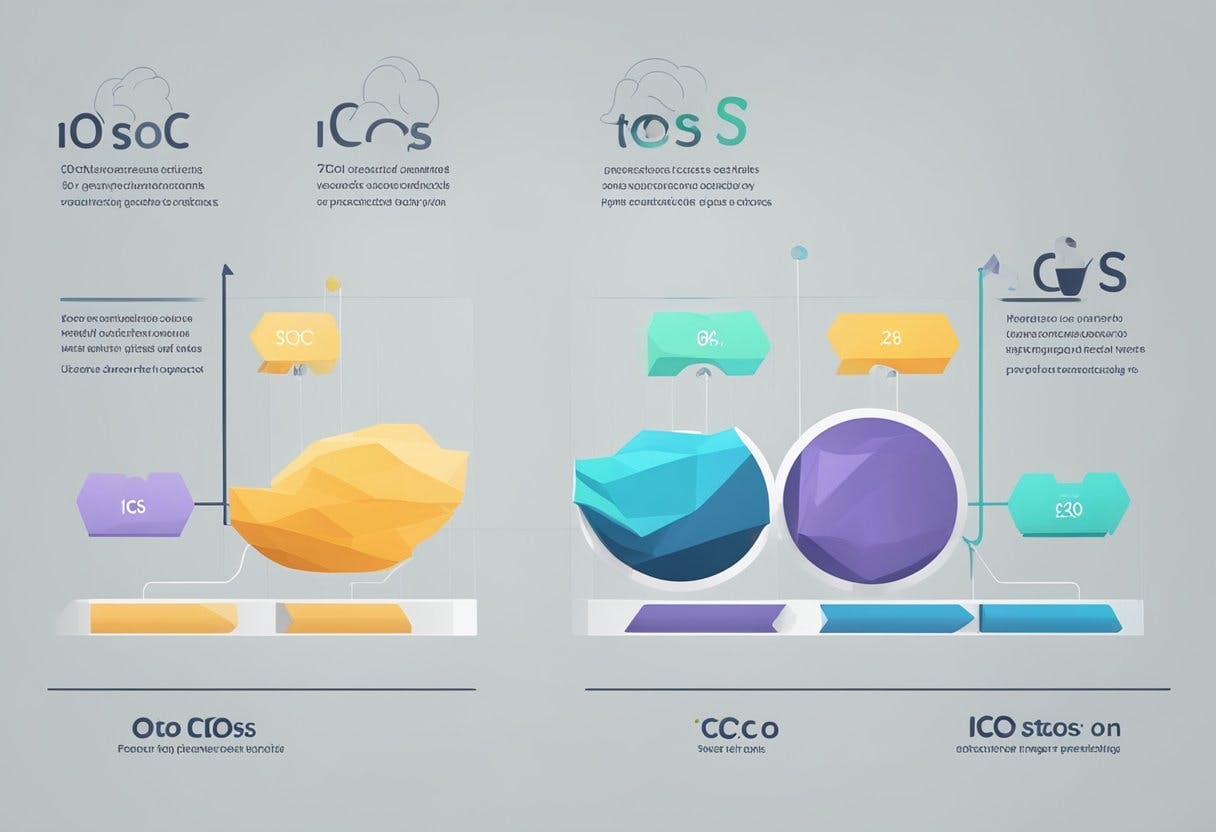
Security Token Offerings (STOs) and Initial Coin Offerings (ICOs) are two popular fundraising methods in the blockchain world. They both involve the sale of a digital token, but there are significant differences between the two. Understanding these differences is crucial for investors and entrepreneurs alike.

ICOs were the first fundraising method to gain popularity in the blockchain world. They involve the sale of a new digital token to investors in exchange for cryptocurrency or fiat currency. ICOs were largely unregulated, which led to a number of scams and fraudulent projects. The lack of regulation also made it difficult for legitimate projects to raise funds. On the other hand, STOs are more regulated and offer more investor protections. STOs are more like traditional securities offerings and are subject to securities laws and regulations.
The regulatory landscape for ICOs and STOs is constantly evolving, and it is important for investors and entrepreneurs to stay up to date on the latest developments. As blockchain technology continues to mature, it is likely that we will see more innovative fundraising methods emerge. However, for now, ICOs and STOs remain the two most popular options for blockchain startups looking to raise funds.
Key Takeaways
- STOs and ICOs are two popular fundraising methods in the blockchain world.
- ICOs were largely unregulated, which led to a number of scams and fraudulent projects.
- STOs are more regulated and offer more investor protections.
Understanding ICOs and STOs

Definition and Purpose
Initial Coin Offerings (ICOs) and Security Token Offerings (STOs) are both methods used by companies to raise funds by selling digital tokens. ICOs were the first to gain popularity, with the first one being held in 2013. ICOs are used to raise funds for a new cryptocurrency or blockchain project by selling utility tokens that grant access to a product or service. STOs, on the other hand, sell security tokens that represent an investment in the company.
The purpose of both ICOs and STOs is to raise capital for a company or project. They offer a new way for companies to access funding without the need for traditional financial institutions. They also provide investors with an opportunity to invest in early-stage projects and potentially make a profit if the project is successful.
Key Differences
The most significant difference between ICOs and STOs is that STOs fall under the purview of regional securities law, whereas ICOs do not. This means that STOs are subject to regulatory oversight, and the tokens sold in an STO are considered securities, while ICO tokens are considered utility tokens.
Another key difference between ICOs and STOs is the level of investor protection. STOs are more regulated and offer investors more protection than ICOs. STOs provide investors with more information about the company, including financial statements, business plans, and other disclosures. In contrast, ICOs often lack transparency and provide little information about the company or project.
ICOs are also more accessible to the general public than STOs. ICOs are open to anyone who wants to invest, while STOs are typically only available to accredited investors. This is due to the regulatory requirements that STOs must meet, which can be costly and time-consuming.
Overall, while both ICOs and STOs offer companies a new way to raise capital, they differ significantly in their regulatory oversight, investor protection, and accessibility. Companies must carefully consider the advantages and disadvantages of each method before deciding which one to use.
Regulatory Landscape

When it comes to the regulatory landscape for ICOs and STOs, there are significant differences. ICOs are not regulated by the SEC, but they are subject to securities laws. On the other hand, STOs are regulated by the SEC, and they are subject to securities laws and regulatory scrutiny.
ICO Regulations
ICOs have faced regulatory scrutiny due to the lack of oversight and the potential for fraud. The SEC has issued warnings to investors about the risks associated with ICOs and has taken enforcement actions against fraudulent ICOs. In addition, the SEC has stated that many ICOs are securities and subject to federal securities laws.
STO Compliance and Oversight
STOs, on the other hand, are subject to regulatory oversight by the SEC. Issuers of STOs must comply with securities laws and regulations, including registration requirements and disclosure obligations. The SEC has also provided guidance on the treatment of STOs and has indicated that many STOs are securities.
Overall, the regulatory landscape for ICOs and STOs is complex and constantly evolving. While ICOs may provide more flexibility and less regulatory oversight, they also carry more risks for investors. STOs, on the other hand, offer greater protection to investors, but they also require more compliance and oversight.
Investment Considerations

Investor Profile
Investors need to consider their profile and investment objectives before investing in STOs or ICOs. STOs are generally considered to be more suitable for institutional investors and high net worth individuals due to their higher minimum investment requirements and longer lock-up periods. ICOs, on the other hand, are more accessible to retail investors due to their lower minimum investment requirements and shorter lock-up periods.
Risks and Rewards
Investors should carefully evaluate the risks and rewards associated with STOs and ICOs before investing. STOs are generally considered to be less risky than ICOs due to their compliance with securities regulations and investor protection measures. However, STOs may have lower liquidity than ICOs, which can make it difficult for investors to sell their tokens in the secondary market. ICOs, on the other hand, are generally considered to be more risky due to their lack of regulatory oversight and investor protection measures. However, ICOs may have higher liquidity than STOs, which can make it easier for investors to sell their tokens in the secondary market.
Market Trends
Investors should also consider the current market trends before investing in STOs or ICOs. The STO market is still in its early stages and is expected to grow in the coming years due to increasing interest from institutional investors and regulatory clarity. The ICO market, on the other hand, has experienced a decline in recent years due to regulatory crackdowns and investor skepticism. However, there are still some promising ICO projects that have the potential to generate significant returns for investors.
In summary, investors should carefully evaluate their investment objectives, risks and rewards, and the current market trends before investing in STOs or ICOs. They should also conduct due diligence on the issuers and their projects to ensure that they are investing in legitimate and viable opportunities.
Technological Infrastructure
Blockchain Technology
Both ICOs and STOs rely on blockchain technology to function. Blockchain technology is a decentralized, distributed ledger that records transactions in a secure and transparent manner. It allows for secure and transparent transactions without the need for intermediaries like banks. Ethereum is the most commonly used blockchain platform for ICOs and STOs.
Smart Contracts and Tokens
Smart contracts are self-executing contracts with the terms of the agreement between buyer and seller being directly written into lines of code. This technology enables the automation of certain processes and eliminates the need for intermediaries. In the context of ICOs and STOs, smart contracts are used to create tokens that represent ownership in a company or project.
ERC-20 tokens are the most commonly used tokens for ICOs. They are programmable and can be customized to meet the specific needs of the project. On the other hand, STOs use security tokens which are backed by real-world assets and subject to securities regulations. Security tokens are designed to be compliant with securities laws and regulations, which is a key difference between STOs and ICOs.
Overall, blockchain technology and smart contracts are essential components of both ICOs and STOs. However, the types of tokens used and the regulations governing them are important distinctions between the two.
Case Studies and Market Analysis
Success Stories
STOs have gained attention in the investment world due to their ability to provide a more secure and regulated investment opportunity compared to ICOs. One successful example of an STO is the Aspencoin project. Aspencoin is a security token that represents fractional ownership in the St. Regis Aspen Resort, a luxury hotel in Colorado. The STO raised $18 million, which was used to renovate and upgrade the hotel. Aspencoin is a prime example of how STOs can be used to raise capital for real-world assets and provide investors with a more secure investment opportunity.
Another success story in the STO market is tZERO, a blockchain-based platform that enables the trading of security tokens. tZERO raised $134 million in its STO, which was used to fund the development and launch of the platform. The platform aims to provide investors with a more efficient and transparent way to trade security tokens. tZERO’s success highlights the potential of STOs to disrupt traditional financial markets.
Challenges and Failures
While STOs have shown promise, they are not immune to challenges and failures. One notable example is the Blockchain Terminal (BCT), which raised $31 million in its ICO. BCT claimed to have developed a secure and transparent platform for trading cryptocurrencies, but it was later revealed that the platform did not exist. BCT’s ICO is an example of the risks associated with investing in ICOs and highlights the importance of due diligence when investing in any blockchain-based project.
Another challenge facing the STO market is the lack of liquidity. Unlike traditional securities, security tokens are not traded on major exchanges, which makes it difficult for investors to sell their tokens. This lack of liquidity has led some investors to question the viability of STOs as an investment opportunity.
Overall, STOs have shown promise as a more secure and regulated investment opportunity compared to ICOs. However, the market is still in its early stages, and there are challenges and risks associated with investing in STOs. As the market matures, it will be interesting to see how STOs evolve and whether they can disrupt traditional financial markets in the same way that bitcoin and other cryptocurrencies have disrupted the world of finance.
Frequently Asked Questions
What are the legal implications of STOs compared to ICOs?
STOs and ICOs have different legal implications. STOs are considered securities and are subject to securities laws and regulations, while ICOs are not always considered securities. This means that STOs have more legal requirements and restrictions compared to ICOs.
How do STOs and ICOs differ in terms of investor rights and protections?
Investors in STOs have more rights and protections compared to investors in ICOs. STOs are subject to securities laws and regulations, which require issuers to disclose more information about the offering and the underlying asset. This information helps investors make informed decisions about the investment. In contrast, ICOs are not subject to the same level of disclosure requirements.
What are the typical regulatory requirements for STOs versus ICOs?
STOs are subject to securities laws and regulations, which vary depending on the jurisdiction. Issuers of STOs are required to comply with these regulations, which include registration requirements, disclosure requirements, and investor protection measures. ICOs, on the other hand, are not subject to the same level of regulatory requirements, although some jurisdictions have issued guidelines or regulations for ICOs.
In what ways do the fundraising mechanisms of STOs and ICOs differ?
The fundraising mechanisms of STOs and ICOs differ in several ways. STOs are typically issued through a registered broker-dealer or crowdfunding platform, which helps ensure compliance with securities laws and regulations. In contrast, ICOs are often issued through a decentralized platform, which makes it difficult to ensure compliance with securities laws and regulations.
How does the token classification impact the compliance of STOs and ICOs?
The token classification impacts the compliance of STOs and ICOs. Tokens that are considered securities are subject to securities laws and regulations, which require issuers to comply with registration requirements, disclosure requirements, and investor protection measures. Tokens that are not considered securities may not be subject to the same level of regulatory requirements.
Can STOs be considered a safer investment than ICOs due to regulatory oversight?
STOs can be considered a safer investment than ICOs due to regulatory oversight. STOs are subject to securities laws and regulations, which require issuers to comply with registration requirements, disclosure requirements, and investor protection measures. This regulatory oversight helps ensure that STOs are issued in a transparent and fair manner, which reduces the risk of fraud and other abuses. In contrast, ICOs are not subject to the same level of regulatory oversight, which increases the risk of fraud and other abuses.
Read More




